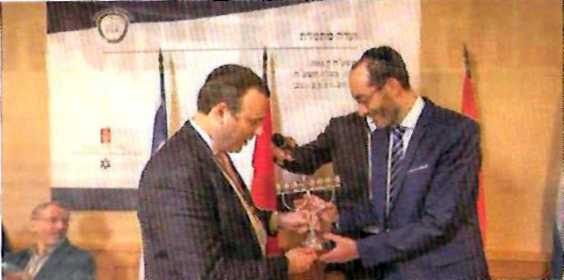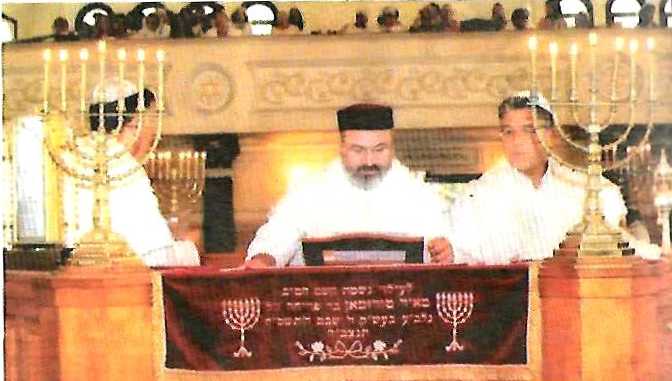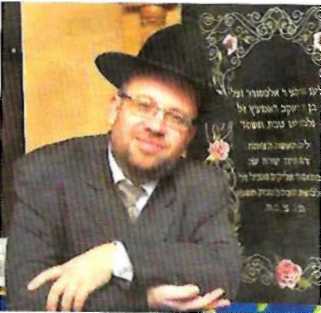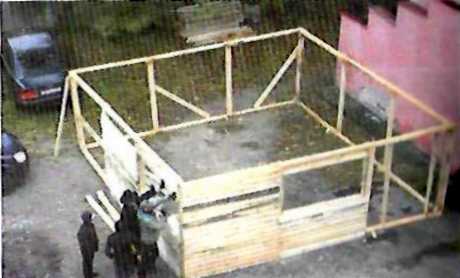Melilla
Melilla is a Spanish autonomous city located on the north coast of Africa, sharing a border with Morocco, with an area of 12.3 km2 (4.7 sq. mi). Melilla is one of two permanently inhabited Spanish cities in mainland Africa, the other being Ceuta. It was part of the Province of Malaga until 14 March 1995, when the city's Statute of Autonomy was passed.
Dancing in Melilla

We have chosen to begin with Melilla, a Spanish enclave in Morocco. Its citizens reject the description of `enclave' and stress at every opportunity that it is an autonomous Spanish area within North Africa which developed long before Morocco existed in its current form. The Jews of this community have many stories to tell about their local history and regard themselves as descendants from the Spanish exiles alongside Jewish survivors from Moroccan Jews who sought to emigrate to Eretz Yisroel but were stuck en route.
The yomim tovim of Tishrei are in the offing. We talked with the rav of the kehilla, HaRav Yehuda Warshaver and heard about the six shuls operating during these days throughout the city. The most prominent ones among these are the central Ohr Zarua, and the Al Mosnino beit haknesset, named so after its founder and first officiating rabbi.
According to Rav Warshaver, most of the services are conducted in the Morocco tradition though in some of the batei knesset, yeshivishe customs have been introduced, initiated by the young folk of the community who studied in Israeli yeshivos and returned home to insert the different melodies and the yeshivishe-Torah ambience.
Few individual families have their own succahs. The shuls build large succahs that are shared by the families.
There are 85,000 residents of which about two-thirds are Moslem. The Jewish community has about 600 members.
The Principality of Monaco
In a conversation with Yated Ne'eman correspondent, Rabbi Tourjemant tells us of the flourishing community in this small principality. "Our community has been in existence for close to thirty-five years. I personally arrived here eight years ago. Last year, we inaugurated a new beit haknesset building named after Edmund Safra which is one of the most beautiful of such edifices and is the center of all communal activities.
Rabbi Tourjemant with one of the benefactors of the community

"Before we focus on the month of Tishrei," he stresses, "it is important to know that despite the fact that the local community does not define itself as religious, the greater majority of its members call themselves traditional Jews. We tender a Kiddush after Shabbos services which bonds all the members of the community who attend and remain to hear a message about the weekly parsha and current issues.
"We have a daily minyan for shacharit, but are somewhat limited for mincha and ma'ariv. But if one of our members has a yahrtzeit, the others make the effort to complete a minyan. We are a very close knit community, very warm with regards to religion and Jewish tradition. Aside from activities for adults, we have significant programs for the youth. On Sundays and Wednesdays, which are national days of rest, we have study classes for Jewish students which are fully attended by the members of the community's families and are very successful in imbuing in the attendees a good measure of `Yiddishkeit'.
"It's no easy matter to organize minyanim. We are doing our utmost to hold on to our spark of Judaism, and are seeing success in our efforts. Last year we hosted the convention of the European Rabbinical Conference, which served admirably to fortify our work within the local community."
The community builds a large Succah near the shuls. Several sets of the four minim are maintained there and used by most of the community.
The community pays for a private security force that is present every week. The local police are also very involved and monitor our activities.
Casablanca, Morocco
Casablanca, or Casa, for short, or in Arabic, Daar Albeida, the largest city in Morocco, lies on the coast of the Atlantic Ocean, some 90 kilometers away from Rabat. Its area is 113 sq. kilometers and its population numbers some seven million residents. Its Jewish community is small and rapidly dwindling.
Rav Hazut saying Selichos

Not only is Casablanca the largest port city in Morocco but the second largest in all of Africa. It is Morocco's economic and financial capital where all business banks and 60% of industrial plants are located.
In a talk with Dayan HaRav Yisrael Hazut, we learned about the unique custom of Morocco's leaders to come and visit the central synagogue on Yom Kippur. It is known that Moroccan kings always held their country's Jews in great esteem and do so to this day. In times of trouble, they always sought the blessings and prayers of the rabbonim of the community.
Carrying on the longstanding tradition, during mincha, government representatives come on Yom Kippur, accompanied by the mayor of Casablanca, to receive the "blessings of the Jews" for the upcoming year. During this ceremony, a Mi shebeirach is recited for His Majesty the King of Morocco, and a memorial prayer for his deceased father and grandfather, "esteemed past kings of Morocco." This old custom has been carried on for many generations.
According to Rav Hazut, "this ceremony constitutes an awesome Kiddush Hashem, year after year. This ceremonial visit is officially heralded and publicized in advance, signifying the Jewish community's allegiance to Morocco. Consequently, it also raises our loyalty and regard in the eyes of all residents of Morocco and thankfully, we experience no anti-Semitism here."
There are a total of 26 batei knesset in the city that function all year round. In recent years a lot of community members choose to spend the holy days with their children in Israel, France or the United States. The Rav says that in the last year there were only three or four male births (he is the main mohel) but many more deaths.
Rav Hazut notes that Moroccan esrogim are world famous and are exported all over the world.
Minsk, Belarus
Minsk is the capital of Belarus and its largest city as well. It is located on the banks of the Svislatz and Niamiha rivers. As a national capital, Minsk has a special status in Belarus and enjoys being the administrative center of the surrounding provinces in the region. It boasts over two million residents, including a small but vibrant Jewish community.
Rabbi Mordechai Richtenstein, chief rabbi

The Yated Ne'eman correspondent conversed with the chief rabbi of the Union of Jewish Communities in Belarus and of the country itself, Rabbi Mordechai Richtenstein, and heard about the Yizkor Jews whose pintele Yid is aroused during this Day and they come to the beit haknesses to pray.
Interestingly enough, Rav Richtenstein tells us, the nussach here is Lithuanian. "We have central minyanim in Minsk and Mohilov, my birth city which has an illustrious Jewish history. During the festivals of Tishrei, we do our best to provide all the needs of the Jewish community, in every sense of the word.
A Succah in Minsk

"Here in Belarus, we contend with a large Jewish community which, doing the year, has no vestige of Judaism. On the other hand, the Jewish spark still smolders within these Jews and on the yomim tovim, we are able to ignite it and draw them to the beit haknesset, some of them because of the communal meals and others because of the Yizkor memorial services. The local government respects our community, and Jewish culture is anchored in law. I can note that government representatives hold us in esteem and are accessible and amenable in even a greater measure than in Israel. A significant portion of our activities are subsidized by government funding."
The four minim are imported from somewhere else every year. This year they will come from Israel. A set can cost about $100 and most families will not buy their own. The entire city of Minsk has about 10 sets.




